Cornflake Crusted Fish and Chips
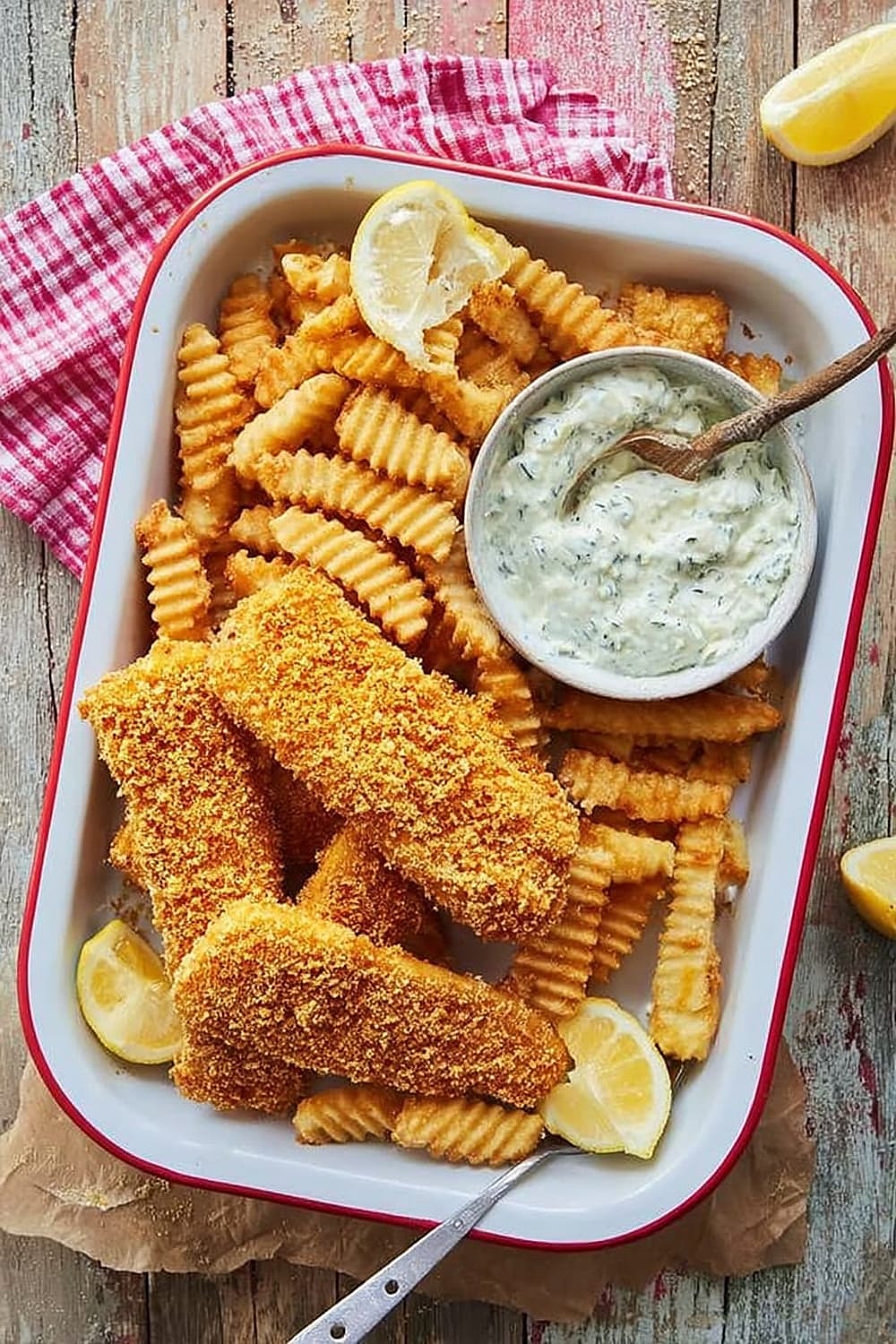
This recipe is basically the grown-up version of eating cereal for dinner, except now you can claim it’s sophisticated because it involves actual cooking.

The cornflake coating creates this ridiculously satisfying crunch that makes regular breadcrumbs seem boring and uninspired.
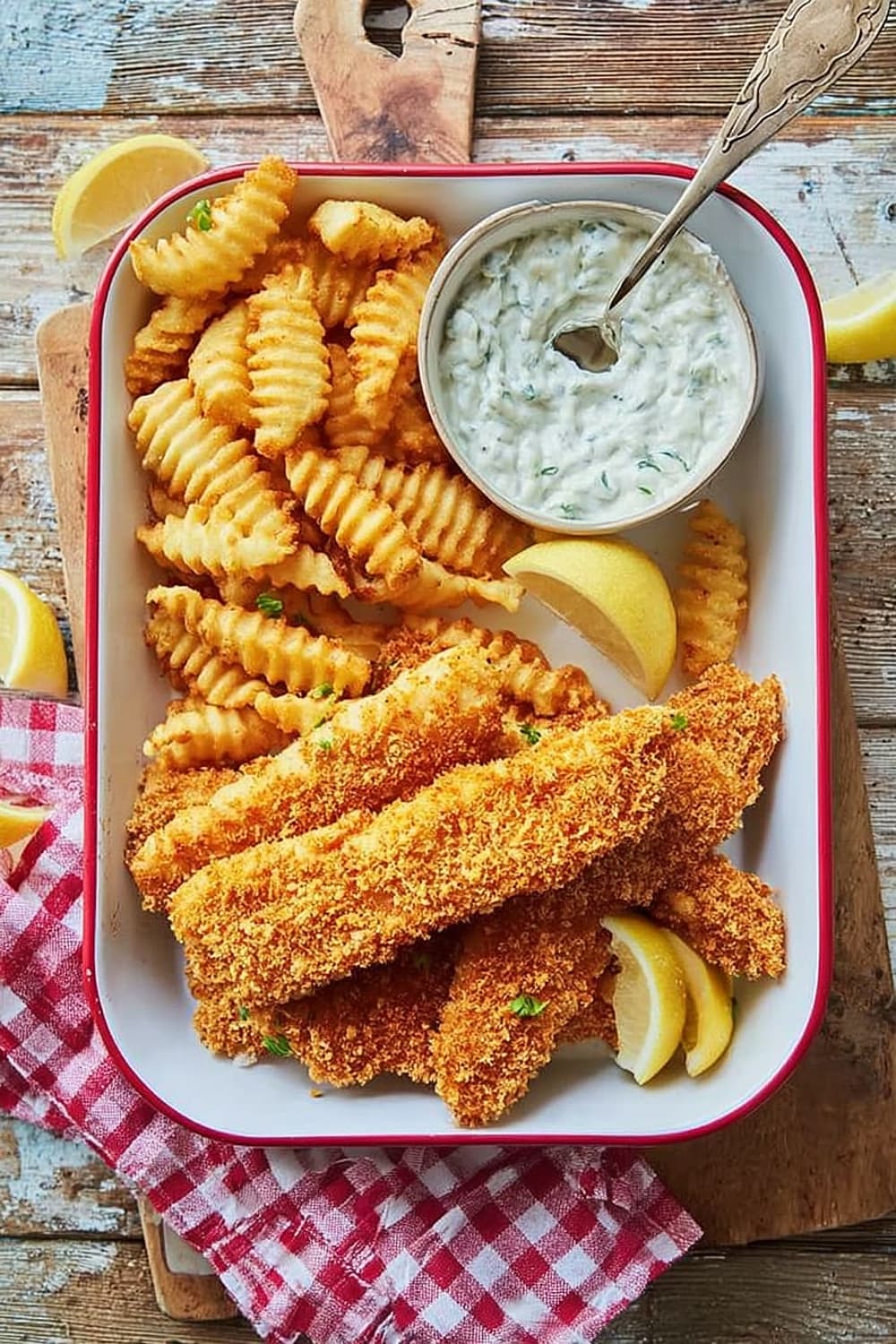
You’ll get perfectly flaky fish inside with a golden, crispy exterior that sounds like a symphony when you bite into it.
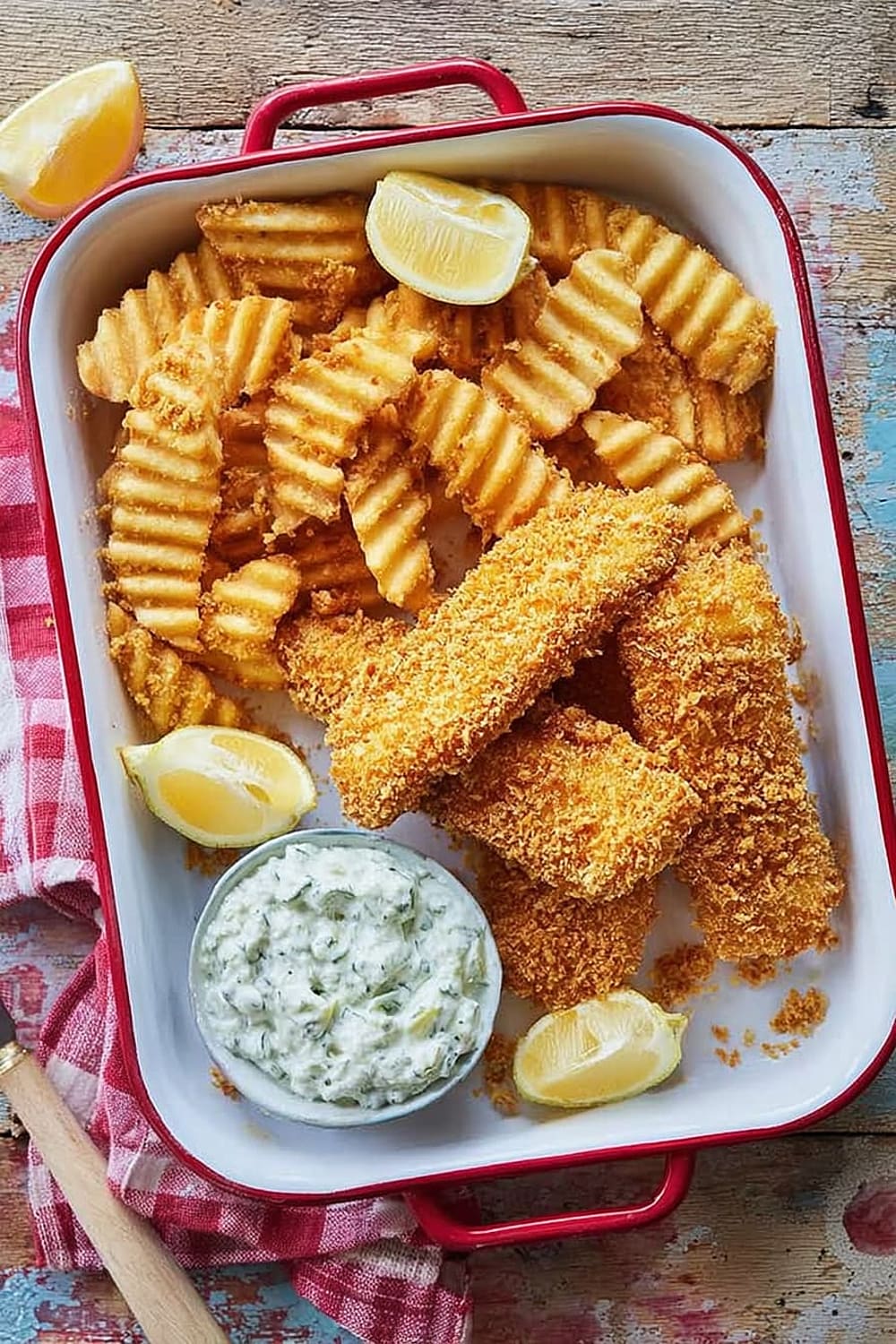
The best part is watching people’s faces when they realize you’ve turned breakfast cereal into the star of dinner.
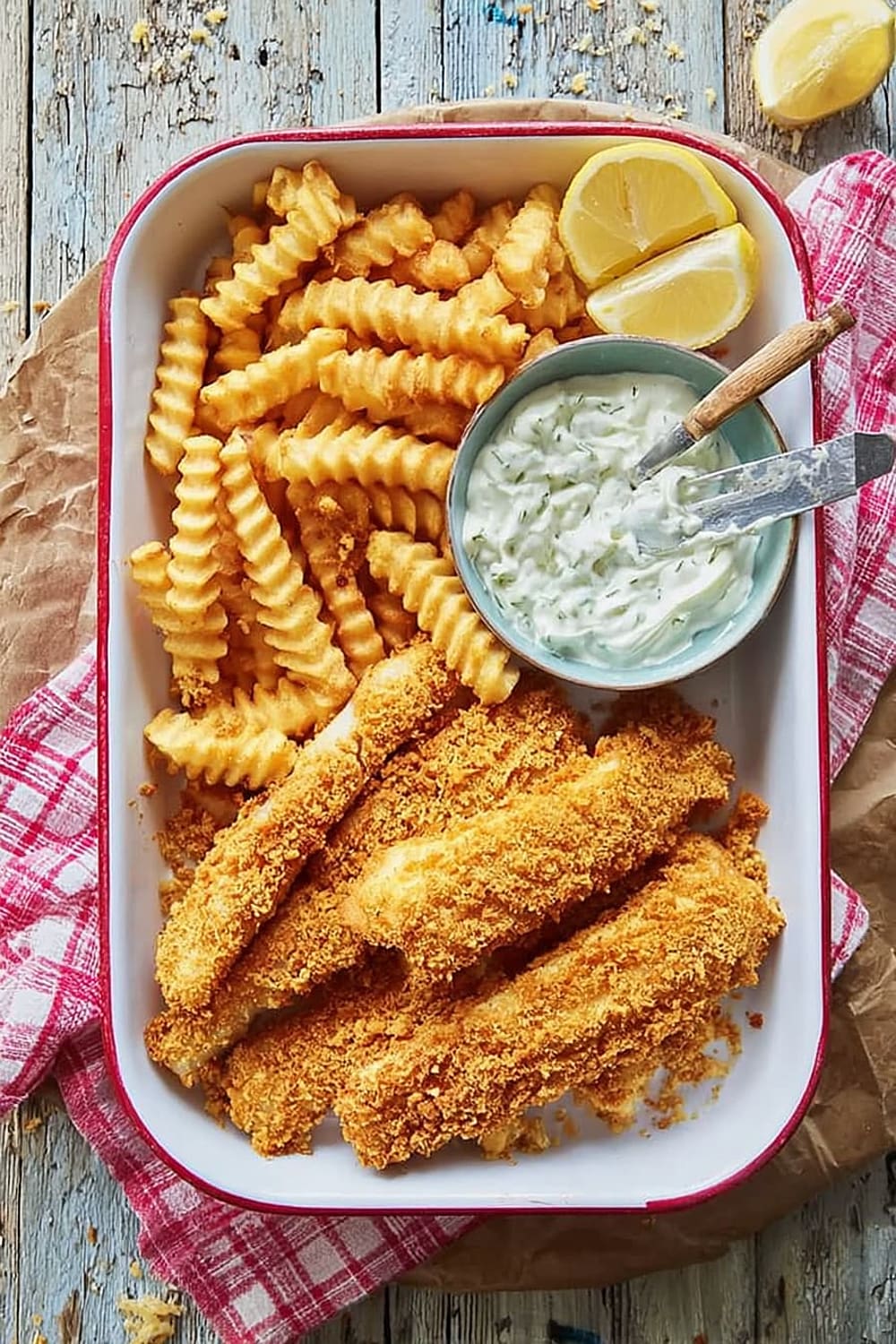
This is the kind of recipe that makes you feel like a culinary genius while using ingredients you probably already have in your pantry.
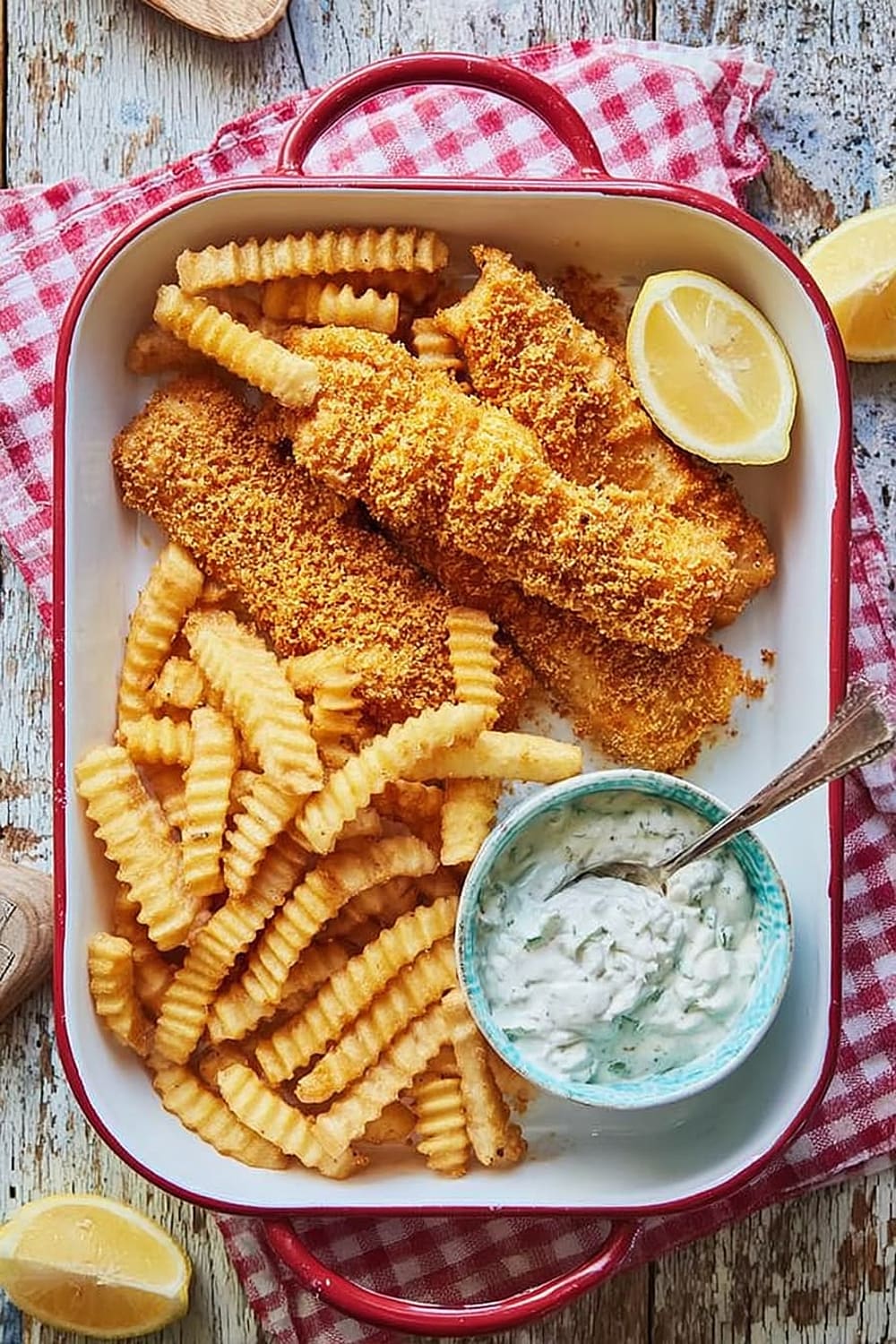
Plus, it’s ready in 20 minutes, which means you can go from “what’s for dinner?” panic to looking like you planned this all along.
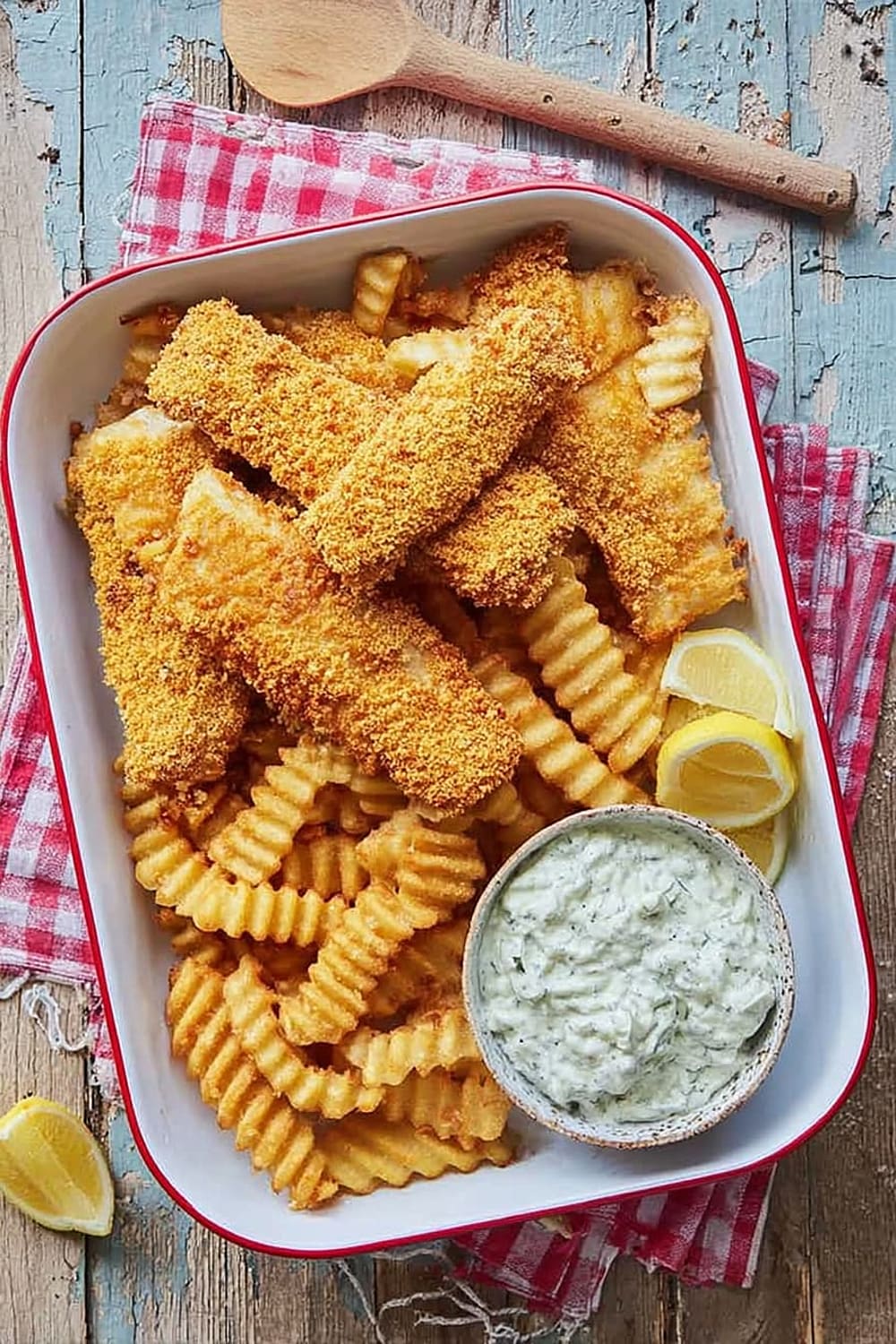
Ingredients
For tartar sauce
- 1 /2 cup mayonnaise
- 2 Tbsp. pickle relish
- 1 Tbsp. diced onion
For fish
- 1 /2 cup all-purpose flour
- Kosher salt and freshly ground pepper
- 2 eggs
- 3 cups cornflakes, well crushed
- 1 lb. cod, tilapia, or other white fish, cut into small fillets
Instructions
Prepare the tartar sauce
- 1 Combine 1/2 cup mayonnaise, 2 tablespoons pickle relish, and 1 tablespoon diced onion in a small bowl. Mix thoroughly until well combined and set aside. This sauce actually improves as it sits, allowing the flavors to meld together while you prepare the fish.
Set up your breading station
- 2 Preheat your oven to 500°F (260°C) and line a baking sheet with aluminum foil for easy cleanup. Place a wire rack on top of the foil-lined baking sheet – this is crucial for allowing air circulation around the fish, ensuring the bottom stays crispy instead of soggy.
- 3 Pour 1/2 cup all-purpose flour onto a small tray or wide bowl and season generously with at least 1 tablespoon kosher salt and freshly ground pepper to taste. The flour mixture should be well-seasoned since this is your first layer of flavor.
- 4 In a second wide bowl, beat 2 eggs with 3 tablespoons water until completely smooth. The water helps thin the egg mixture slightly, making it easier to coat the fish evenly without clumping.
- 5 Add 3 cups well-crushed cornflakes to a third tray or shallow dish. For best results, crush the cornflakes using a food processor or by placing them in a sealed bag and rolling with a rolling pin until they’re broken into small, uniform pieces but not powdered.
Bread and bake the fish
- 6 Pat the fish fillets completely dry with paper towels and season both sides generously with kosher salt and freshly ground pepper. Moisture is the enemy of crispy coating, so don’t skip this step.
- 7 Working with one fillet at a time, dredge first in the seasoned flour, shaking off excess. Next, dip into the egg mixture, allowing excess to drip off. Finally, roll thoroughly in the crushed cornflakes, pressing gently to help the coating adhere. Place each coated fillet on the wire rack.
- 8 Bake in the preheated 500°F (260°C) oven for 10-12 minutes until the fish is just cooked through and flaky when tested with a fork. The internal temperature should reach 145°F (63°C) and the coating should be golden brown and crispy.
Air fryer alternative
- 9 To make in an air fryer, arrange as many fillets as will fit comfortably in the basket without overcrowding. Cook at 400°F (204°C) for 4-6 minutes, turning halfway through cooking time for even browning.
Recommended Equipment and Kitchen Tools
Essential Tools (for best results)
- Wire cooling rack – This is crucial for crispy results as it allows air circulation around the fish, preventing soggy bottoms that plague many baked fish recipes
- Digital instant-read thermometer – Takes the guesswork out of doneness, ensuring perfectly cooked fish every time without overcooking
- Three shallow dishes or trays – Wide, shallow containers make the breading process much more efficient and less messy than deep bowls
- Aluminum foil – Lines your baking sheet for easy cleanup and reflects heat for more even cooking
Helpful Upgrades
- Food processor – Makes crushing cornflakes incredibly quick and uniform, though a rolling pin and sealed bag works as a budget alternative
- Kitchen scale – For precise measurements, especially helpful when scaling the recipe up or down for different crowd sizes
- Silicone-tipped tongs – Perfect for flipping delicate fish fillets without breaking the crispy coating
- Parchment paper – Can substitute for foil and provides excellent non-stick surface
Nice-to-Have Options
- Cast iron skillet – If you prefer pan-frying instead of baking, though the oven method is healthier and easier
- Mandoline slicer – Useful for making homemade chips to complete the fish and chips experience
- Storage containers – Glass containers with tight-fitting lids keep leftover tartar sauce fresh for up to a week
Recipe Variations and Dietary Modifications
Gluten-Free Adaptation
- Replace all-purpose flour with 1/2 cup gluten-free flour blend (cup-for-cup substitution works perfectly)
- Ensure your cornflakes are certified gluten-free, as some brands contain malt flavoring
- The texture remains virtually identical with this simple swap
- No adjustments needed for baking time or temperature
Dairy-Free Modifications
- This recipe is naturally dairy-free as written
- For the tartar sauce, use vegan mayonnaise if following a strict dairy-free diet
- Some mayonnaise brands contain dairy, so check labels carefully
Lower-Carb Version
- Replace flour with 1/2 cup almond flour or crushed pork rinds for the first coating
- Substitute cornflakes with crushed nuts (pecans or almonds work beautifully)
- Use crushed cheese crisps for an ultra-low-carb, high-protein coating
- These modifications reduce carbs by approximately 15-20 grams per serving
Flavor Variations
- Spicy version: Add 1 teaspoon cayenne pepper and 1 teaspoon paprika to the cornflake coating
- Herb-crusted: Mix 2 tablespoons dried herbs (thyme, oregano, parsley) into the cornflakes
- Parmesan upgrade: Add 1/2 cup grated Parmesan cheese to the cornflake mixture for extra richness
- Lemon-pepper: Incorporate 2 teaspoons lemon zest and extra black pepper into the coating
Nutritional Information and Health Benefits
Key Nutritional Highlights
Each serving provides approximately 280-320 calories, with the majority coming from high-quality lean protein. The fish delivers about 25-30 grams of complete protein, making this an excellent choice for muscle maintenance and satiety. The cornflake coating adds roughly 15-20 grams of carbohydrates, while the preparation method keeps fat content moderate at 8-12 grams per serving.
Health Benefits of Main Ingredients
White fish like cod and tilapia are excellent sources of lean protein, containing all essential amino acids while being naturally low in saturated fat. These fish provide significant amounts of vitamin B12 for nervous system health, selenium for antioxidant protection, and phosphorus for bone health. The eggs in the coating contribute additional high-quality protein, choline for brain function, and lutein for eye health.
Dietary Considerations
This recipe is naturally gluten-free when made with certified gluten-free cornflakes and gluten-free flour. It’s also dairy-free as written, making it suitable for those with lactose intolerance. The baking method significantly reduces oil content compared to traditional fried fish and chips, making it heart-healthier while maintaining the satisfying crunch. Each serving provides about 2-3 grams of fiber from the cornflake coating, and the lean protein helps stabilize blood sugar levels.
Smart Swaps and Ingredient Substitutions
Common Substitutions:
- All-purpose flour → Rice flour or potato starch (use same amount for gluten-free option)
- Cornflakes → Crushed rice cereal, panko breadcrumbs, or crushed crackers (maintain 3-cup volume)
- Cod or tilapia → Halibut, mahi-mahi, catfish, or flounder (any firm white fish works)
- Pickle relish → Finely diced pickles or capers (use 2 tablespoons)
Budget-Friendly Swaps:
- Fresh fish fillets → Frozen fish fillets (thaw completely and pat very dry before breading)
- Name-brand cornflakes → Generic cornflakes (taste and texture are virtually identical)
- Mayonnaise → Greek yogurt for lighter tartar sauce (use 1/4 cup yogurt + 1/4 cup mayo)
Pantry Emergency Substitutions:
- No cornflakes → Crushed saltine crackers or breadcrumbs mixed with 1 teaspoon garlic powder
- No eggs → 1/2 cup buttermilk or milk for coating (creates slightly different but still delicious texture)
- No pickle relish → 1 tablespoon minced pickles + 1 teaspoon pickle juice
Pro Tips for Substitutions:
- Store extra crushed cornflakes in an airtight container for up to 3 months
- When using frozen fish, thaw in refrigerator overnight and pat completely dry before coating
- Adjust seasoning when using different cereals, as some are saltier than others
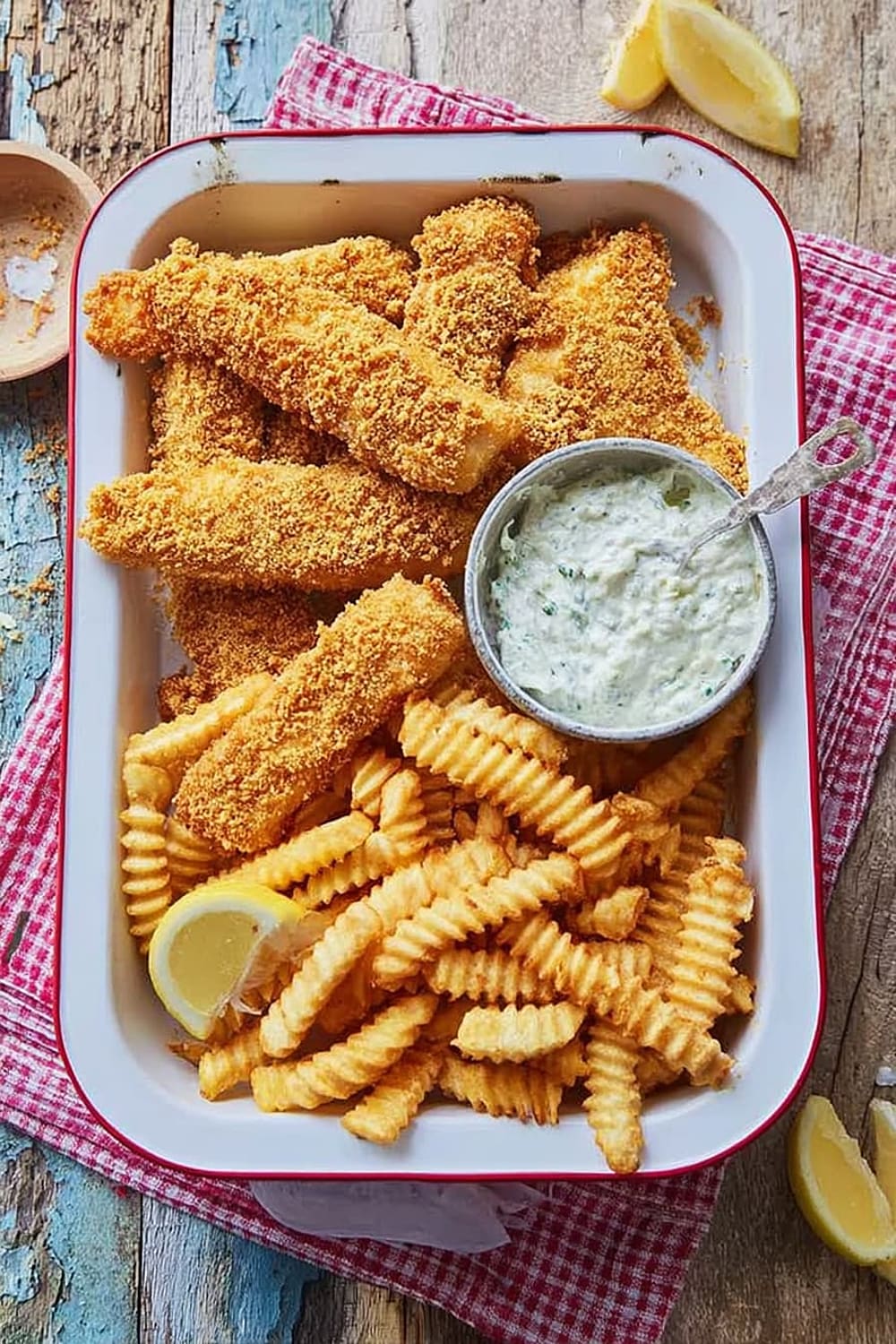
Make It Diabetes-Friendly
Carb Reduction Strategies:
- Replace all-purpose flour with almond flour to reduce carbs by approximately 8-10 grams per serving
- Substitute cornflakes with crushed almonds or pecans for a 15-gram carb reduction
- Use crushed pork rinds as coating for virtually zero carbs while maintaining crunch
Portion & Timing Tips:
- Recommended serving size: 4-5 oz fish fillet provides adequate protein while keeping carbs manageable
- Estimated carbs per serving: 18-22 grams with traditional coating, 8-12 grams with nut-based coating
- Pair with: Non-starchy vegetables like roasted broccoli or green beans to add fiber and nutrients
- Timing: Eat within 2 hours of exercise when possible to optimize blood sugar response
Enhanced Protein Options:
- Add 1 tablespoon ground flaxseed to coating for extra fiber and omega-3s
- Serve with Greek yogurt-based tartar sauce for additional protein and probiotics
- Include a side salad with olive oil dressing to slow carbohydrate absorption
Total Carb Reduction: Using almond flour and nut coating can reduce total carbs from 20 grams to 6-8 grams per serving
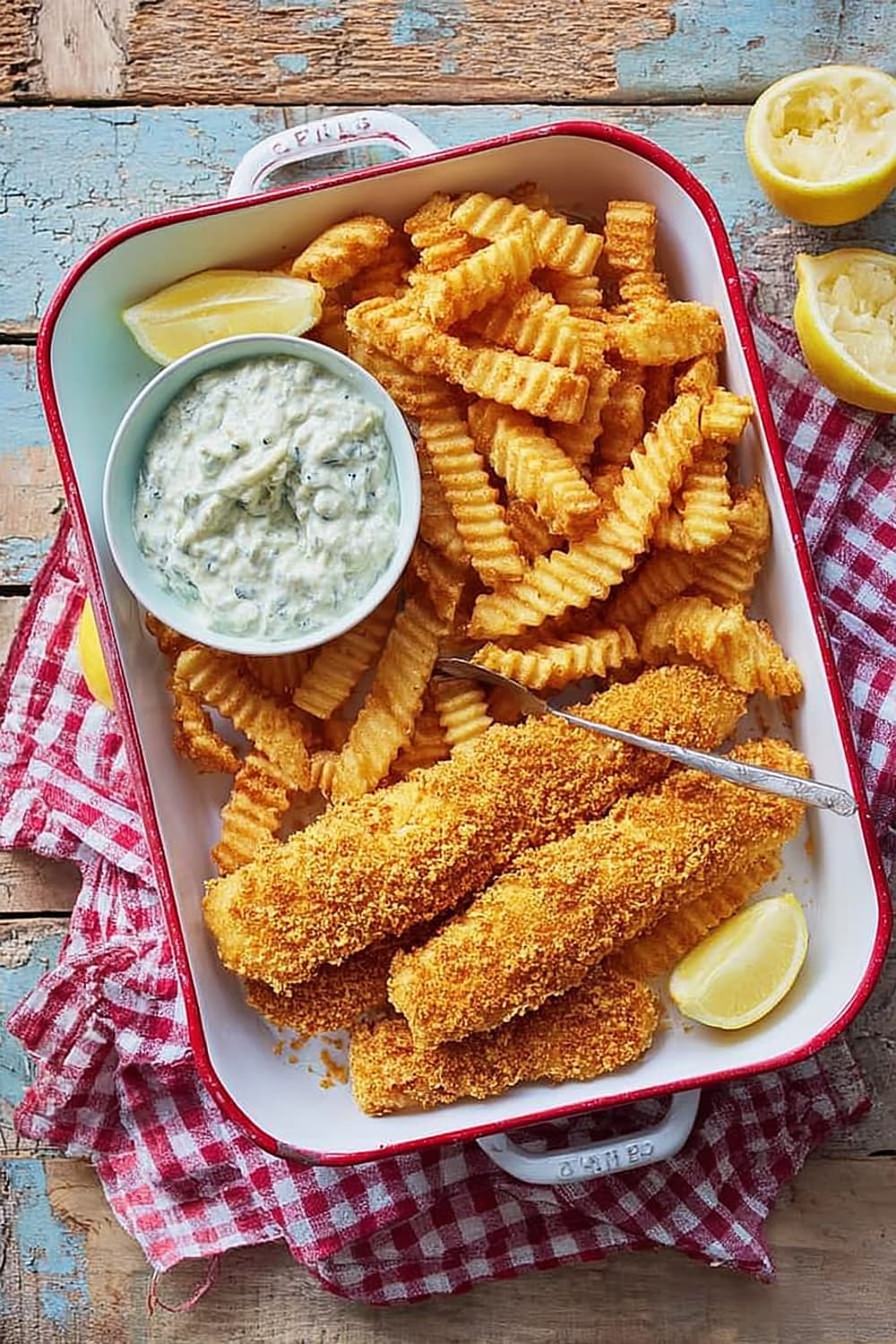
Perfect Pairing Suggestions
Beverage Pairings
Crisp white wines like Sauvignon Blanc or Pinot Grigio complement the delicate fish without overwhelming its flavor. For beer lovers, light lagers or wheat beers provide refreshing contrast to the crispy coating. Non-alcoholic options include sparkling water with lemon, iced tea, or cucumber-infused water that cleanse the palate between bites.
Side Dish Recommendations
Roasted sweet potato wedges create a healthier take on traditional chips while adding natural sweetness that balances the savory fish. Coleslaw provides cooling crunch and acidity that cuts through the richness. Steamed green beans or roasted Brussels sprouts add color and nutrients, while corn on the cob embraces the comfort food theme. Garlic mashed cauliflower offers a low-carb alternative to traditional mashed potatoes.
Complete Meal Ideas
Start with shrimp cocktail or clam chowder to create a seafood-focused menu. Build a British pub experience with mushy peas, malt vinegar, and thick-cut chips. For lighter fare, serve alongside quinoa salad with fresh herbs and lemon vinaigrette. Key lime pie or lemon bars make excellent desserts that complement the meal’s coastal theme.
Occasion Suggestions
Perfect for casual Friday dinners, family game nights, or weekend entertaining when you want something special but not fussy. Excellent for kids’ parties since the familiar cornflake coating appeals to young palates. Great for Lenten meals or healthy eating goals when you want comfort food that fits your nutritional needs.
Pro Tips and Troubleshooting
Professional Techniques
Pat fish completely dry before seasoning – excess moisture prevents proper coating adhesion and creates soggy results. Season each layer (flour, fish, and coating) rather than relying on just one seasoning step for maximum flavor impact. Use the wire rack without exception – this single step makes the difference between restaurant-quality crispy coating and disappointing soggy fish.
Common Mistakes and Solutions
Overcrowding the pan leads to uneven cooking and steaming instead of crisping. Cook in batches if necessary, keeping finished pieces warm in a 200°F (93°C) oven. Skipping the flour step results in coating that falls off during cooking. Not preheating the oven fully to 500°F (260°C) prevents proper browning and crisping.
Storage and Reheating
Refrigerate leftovers for up to 3 days in airtight containers. Reheat in a 400°F (204°C) oven for 5-7 minutes to restore crispiness – never use the microwave, which makes coating soggy. Tartar sauce keeps for up to 1 week refrigerated.
Make-Ahead Strategies
Bread the fish up to 4 hours ahead and refrigerate on the wire rack, covered with plastic wrap. Make tartar sauce up to 3 days ahead for better flavor development. Crush cornflakes in large batches and store in airtight containers for quick future meals.
Recipe Scaling
Double the recipe easily by using two baking sheets and wire racks. Cooking time remains the same – just rotate pans halfway through for even browning. Tartar sauce scales perfectly and actually improves when made in larger batches.
This cornflake-crusted fish delivers all the satisfaction of traditional fish and chips with a fraction of the oil and mess, proving that sometimes the most brilliant culinary innovations come from thinking outside the box – or in this case, outside the breadcrumb container.